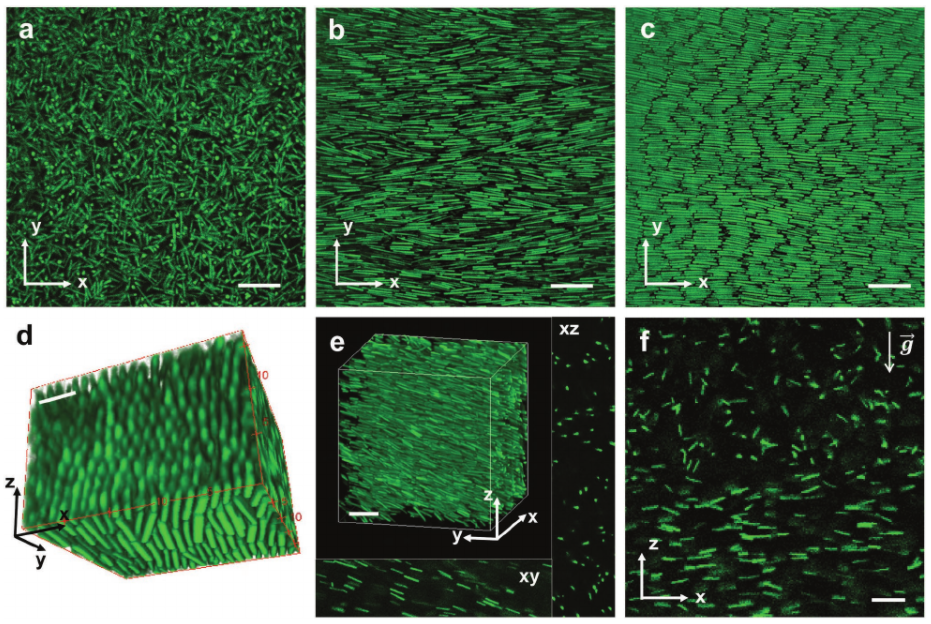Elastic Microphase Separation Produces Robust Bicontinuous Materials
Carla Fernández-Rico, Sanjay Schreiber, Hamza Oudich, Charlotta Lorenz, Tianqi Sai, Alba Sicher, Stefanie Heyden, Pietro Carrara, Laura de Lorenzis, Robert W. Style and Eric R. Dufresne. Nature Materials, 124–130, (2024).

In this work, we introduced a new phase separation process: Elastic MicroPhase Separation (EMPS), which allows to produce bicontinuous materials with tunable dimensions in polymer networks. By analyzing the microstructure, phase equilibria, and kinetics of this process, we demonstrated that bicontinuous structures emerge through a unique thermodynamic pathway, featuring aspects of both nucleation and growth and spinodal decomposition. This has important implications for soft matter physics, as it challenges classical models for phase separation, but also for material science, as it offeres an alternative and robust method to produce composite bicontinuous structures at the micronscale.
Effect of curvature on the diffusion of colloidal bananas
Justin-Aurel Ulbrich, Carla Fernández-Rico, Brian Rost, Jacopo Vialetto, Lucio Isa, Jeffrey S. Urbach and Roel P. A. Dullens. Phys. Rev. E 107, L042602 (2023).

In this work, we investigate the diffusion of colloidal bananas in two dimensions as a function of their curvature. We find that those particles with have an opening angle below than 180°, diffuse faster along the long axis of the particles, but that this switches when the opening angle of the particles is above 180°. We compare this results with a minimal slender body theory, and find that the behaviour of the particles can be essentially explained by local drag anisotropic forces. These results help us understand further the complex banana assemblies seen in our previous work and also contribute to the understanding of diffusion of complex colloidal particles.
Putting the Squeeze on Phase Separation
Carla Fernández-Rico, Tianqi Sai, Alba Sicher, Robert W. Style and Eric R. Dufresne. JACS Au 2, 66-73 (2022).

In this Perspective, we discuss the advances of phase separation tools to fabricate nano- and microstructured materials. A close look at the natural world suggests us that there is still significant room for improvement. Nonetheless, we highlight some emerging approaches to control phase separation based on mechanical constraints, and discuss potential links with the phase-separation processes observed in bird feathers. Finally, we outline a number of challenges and opportunities on the horizon for understanding and exploiting elastically controlled demixing processes.
Hierarchical self-assembly of polydisperse colloidal bananas into a two-dimensional vortex phase
Carla Fernández-Rico and Roel Dullens. PNAS 118, e2107241118 (2021).

In this work, we show that polydisperse colloidal bananas self-assemble into a complex and hierarchical quasi–two-dimensional structure, called the vortex phase, only due to excluded volume interactions and polydispersity in the particle curvature. Using confocal microscopy, we uncover the remarkable formation mechanism of the vortex phase and characterize its exotic structure and dynamics at the single-particle level. These results demonstrate that hierarchical self-assembly of complex materials can be solely driven by entropy and shape polydispersity of the constituting particles.
Shaping colloidal bananas to reveal biaxial, splay-bend nematic, and smectic phases
Carla Fernández-Rico, Massimiliano Chiappini, Taiki Yanagishima, Heidi de Sousa, Dirk Aarts, Marjolein Dijkstra and Roel Dullens. Science 369, 950 (2020).

In this work, we have synthesised colloidal banana-shaped particles that mimic bent-core liquid crystals. Unlike their molecular counterparts, the fluorescent, micron-scale bananas with controllable curvature, can be observed using confocal imaging. By varying particle curvature and packing fraction, we produced a range of ordered phases, including one, the splay-bend nematic phase, that was predicted 40 years ago but remained unobserved until now.
Find a simple and short press release summary of our research here.
Synthesis of Colloidal SU-8 Polymer Rods Using Sonication
Carla Fernández-Rico, Taiki Yanagishima, Arran Curran, Dirk Aarts and Roel Dullens. Advanced Materials 31, 1807514 (2019)

Figure 1. a) Schematic of the synthesis of Colloidal SU-8 rods. b) and c) Scanning Electron Microscopy images, and (d) optical microscopy images of the colloidal rods
In this work, we developed a system of colloidal rods, which are made of a photoresist called SU-8, that mimic conventional liquid crystal forming molecules. The unique tunability of the optical properties and effective gravity of this system, allowed us to use confocal microscopy to image dense liquid crystal phases of particles and also optical tweezers to locally manipulate them.

Wet-Chemical Synthesis of Chiral Colloids
Samia Ouhajji, Bas G. P. van Ravensteijn, Carla Fernández-Rico, Kanvaly S. Lacina, Albert P. Philipse, Andrei V. Petukhov. ACS Nano 12, 12089 (2018)

In this work, we developed a method to produce chiral colloids by confining spherical colloids in cylindrical micro-tubes. The surface of the particles was functionalised with photosensitive molecules, such that when they formed chains inside the tubes, we could fix their arrangement using UV-light. The confining tubes were subsequently removed by just adding water, and nicely free-standing chiral and achiral structure were obtained in dispersion.
